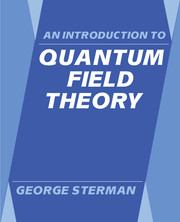Book contents
10 - Introduction to renormalization
Published online by Cambridge University Press: 05 August 2012
Summary
Chapter 9 has left us in an awkward position with regard to quantum corrections. Ultraviolet divergent diagrams can be computed only by continuing to unphysical numbers of dimensions (or otherwise regularizing). In this chapter, we develop the process of renormalization, which will allow us to return many theories to physical dimensions.
It is possible to make the perturbation series of many theories finite, at the price of making certain parameters in their Lagrangians infinite. From one point of view, renormalization provides a positivistic morality play, in which, by renouncing our ability to calculate a few unobservable quantities (‘bare’ quantities below), we gain many predictions relating observable quantities. It may be unsettling, however, to deal with a Lagrange density that becomes infinite when the regularization is removed, even if it does give a finite perturbation series. Thus the perennial conjecture arises, that the quantum fields in nature are low-energy manifestations of an underlying finite theory. The most recent, and most promising, candidate is string theory (Green, Schwarz & Witten r1987). Here we shall simply examine renormalization as a self-consistent procedure, without asking for the ultimate origin of renormalizable theories.
We begin our discussion with the simplest case in which renormalization is necessary, ϕ3 theory in four dimensions (ϕ34).
- Type
- Chapter
- Information
- An Introduction to Quantum Field Theory , pp. 280 - 318Publisher: Cambridge University PressPrint publication year: 1993



